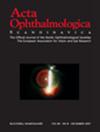Fundus autofluorescence lifetimes in age-related macular degeneration versus healthy controls in a pseudophakic population
Abstract
Purpose
To check whether prolonged fundus autofluorescence (FAF) lifetimes in age-related macular degeneration (AMD) could be an artefact resulting from lens fluorescence.
Methods
Fluorescence lifetime imaging ophthalmoscopy (FLIO) was performed in pseudophakic intermediate AMD as well as healthy controls. The median values of FAF lifetimes in the centre, the inner and the outer ring of the ETDRS grid, obtained as amplitude-weighted mean of the lifetimes from a three-exponential fit of the fluorescence decay over time in two spectral channels, as well as peak emission wavelengths (PEW) were compared between patients and controls. The age dependence of FAF lifetime was checked per group. In the patient cohort, FAF lifetimes of individuals with and without subretinal drusenoid deposits (SDD) were compared.
Results
Forty-four AMD patients (mean age 80.0 ± 6.0 years) and 26 controls (mean age 73.0 ± 10.2 years) were included. The FAF lifetimes of a subgroup of patients (N = 25, mean age 76.3 ± 5.6 years), age-matched to the controls, were significantly longer than those of the controls (all grid areas and spectral channels p < 0.001). FAF lifetimes increased with age in the controls (p = 0.006–0.03), but not in the patients. Patients with SDD had longer FAF lifetimes than those without (p = 0.003–0.068). PEW neither showed significant group differences nor age dependence.
Conclusions
Although long fluorescence lifetimes of the lens can affect FAF lifetime measurements, prolonged FAF lifetimes in AMD are specific to the disease and not a lens artefact as shown in pseudophakic eyes. The effect of AMD on the lifetimes outweighs that of age. Patients with SDD, who have a higher risk of AMD progression, also show longer FAF lifetimes.


 求助内容:
求助内容: 应助结果提醒方式:
应助结果提醒方式:


